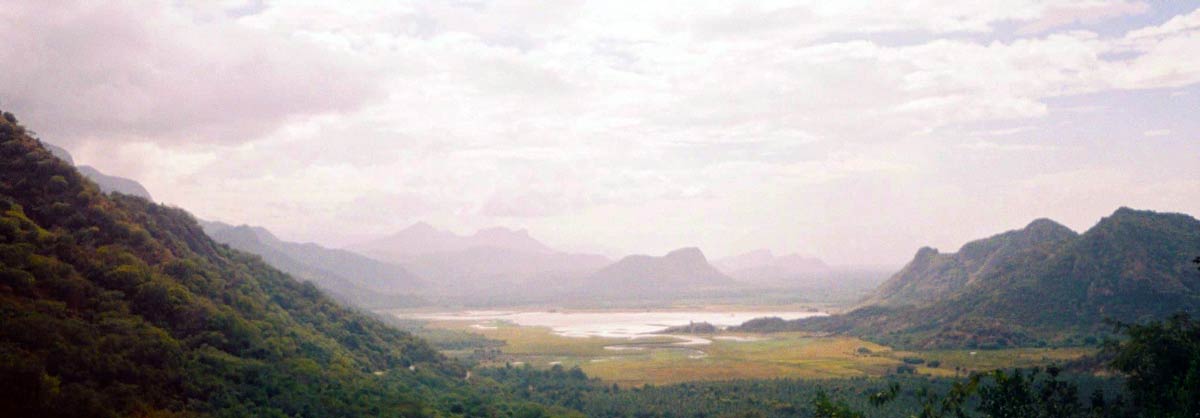
Kodaikanal near Palani
The Cittars/Siddhas
‘A siddha is a free thinker and a revolutionary, refusing to allow himself to be carried away by religion, scripture, or ritual, denouncing idol worship,
ritualistic practices and petitionary prayers as fetters holding back the soul.’ says Professor T.N. Ganapathy in
The Philosophy of the Tamil Siddhas.
Palani
The town Palani is known as the Siddha Bhumi, the seat of power on earth by the Siddhas. Amongst many other names it is called Siddhan Valvu, the place of knowledge on earth.
One of the busiest temple towns in India, religious devotees in their thousands flock here daily to visit the temple dedicated to the worship of Lord
Murukan or Murugan son of Lord Siva. Orthodox Muslims as well as Hindus pay regular visits to Palani for worship. For them, the Lord is known as Palani
Bådshah.
Lit up at night, the temple complex stands high on the mountain of solid rock.
In the old days elephants meandered up steep pathways transporting eager devotees to the temple complex above. Today cable cars on one side and a rail
locomotive system on the other transport the faithful from five o’clock in the morning to ten at night amidst a cacophony of music coming from every
conceivable loudspeaker system.
All sing the glories and praises of Siva, Palani and Lord Murugan.
Legends speak of Palani Hill as the hill that is the salvation of the world in the shape of the Siva Linga. It is Brahman, the Jyoti Mountain. The Hill,
which gives boons to even Brahma and Vishnu when they worship there, is more sacred and ancient than Kasi (Varanasi) on the Ganga. It is the Hill, on which
flower forth marvels which can never be dimmed. It is the Hill of Bliss, which the fourteen worlds acclaim; it is the great Hill which sunders the chain of
birth at one darshan (sighting). It is the hill worshipped by Arunagiri.
The Heart of Siddha Yoga
Because of popular thinking we can be forgiven for assuming that Yoga originates in the Himalayas. Yogis have always gone to the mountains to get away from society. But historically Tamil Nadu may have a lot more to do with yoga than the north. The roots of yoga I discovered may have originated there.
The Tamil language is thought to be one of the oldest on earth. With its roots in the Dravidian culture, Latin, Chinese and many Asian languages are said to trace back to ancient Tamil.
The Dravids or Dravidians were a thriving civilization that existed in Harappa, Mohenjodaro in the Indus valley over 9000 years ago. The word Dravida is a Sanskrit word that means ‘vagabond’ and it comes from Dru meaning ‘to move’. To say that the Dravids and the ancient Druids
are the same would not be too much of a stretch.
There are 32 Tamil or Thamizh dialects found between South America, South Africa and Australia. The language is said to have migrated from its cradle in
ancient Kondwana or Gondwana moving south north, north south, north west, north east as human migration spread after the ice age.
Delving deeper into the Tamil legacy you discover much of India’s rich culture derives in some way from the Tamil or ancient Dravidian Culture.
The Siddha doctors talk of Sanskrit as a code, password, or shadow language used by the siddhas to convey the hidden secrets and meaning of yoga.
A priest showed me how in speaking Tamil as opposed to Sanskrit, the tip of the tongue is constantly in touch with the upper palate, closest to
consciousness. For this reason they talk of Tamil or Thamizh as being the ‘Language of God’.
The Journey Begins : Pulippani Ashramam
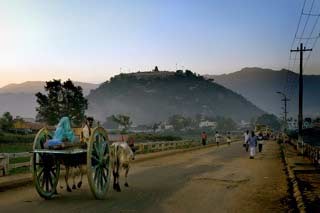
Palani - Siva Giri
Early one morning getting aboard my Enfield named Buddha after its rich exhaust note ‘buddha buddha . buddha . . ‘, I headed south out of Chennai along
East Coast Road travelling inland into the heart of Siddha country. My curiosity was piqued upon hearing that an ancient Siddha tradition, the Bhoganathar Pulippani Siddha Parampai, with roots stretching back 5000 years still existed in Palani.
The Pulippani ashram is found hidden between chai stalls on the road adjacent to the main temple entrance.
Here I met Sivananda Pulippani Pathira Swamigal, the head of the ancient tradition for the first time. Wearing saffron he was seated on an
aged tiger skin on top of an old chair covered in gold plate. His deep sparkly eyes met mine as he observed me. Faded paintings and black and white
photographs of the ancient line of gurus hung on the walls, as the ceiling fan blowed noisily in the small room.
The group of Tamils seated around Swamigal started firing questions at me, “Why are you here? What do you want from Swamigal? How long have you been in
India? Where do you come from? What can we do for you?”
Explaining my interest in the Siddha tradition, I become the topic of intense debate. Tamils, as I learned, love debating and debate endlessly on all
manner of things.
I also learned that they have very little regard for northern Indians, some even refusing to allow northerners in their homes. Hence my interrogation. As
this particular debate unfolded more questions were fired at me, until they finally extended the friendliest and warmest of welcomes, and everyone
introduced themselves by shaking my hand and nodding their heads in the traditional manner.
Food was then offered, and a wizened old man was introduced to me as the yoga expert. In depth conversation on the philosophy and ancient matters of yoga
was conducted with the help of an interpreter. I was told that the Siddhas loved Southern Africa and visited there in the past. They said that yoga comes
from animals.
As we finished our meal, photos were taken with Swamigal. As I was thanking him for the hospitality, he insisted I’d stay at the ashram.
‘My ashramam, your ashramam. He said, looking at me.
Explaining I needed a shower, Swamigal allowed me to lodge the night at a hotel across the road.
As I was leaving, he gave me strict instructions to go to the hilltop temple for Darshan as soon as possible. Later that afternoon, received by
his brother and the Brahmin priests as a guest of honor, I had my first Darshan of Lord Murugan.
Seated next to the Bhogar Samadhi shrine afterwards, I was immersed in an overwhelming sense of belonging.
The Brahmin priests that I met at the temple, as I found out some time after, have been intimately linked to the family ever since the king of Mysore
wanted Darshan of Lord Murugan around 800 years ago.
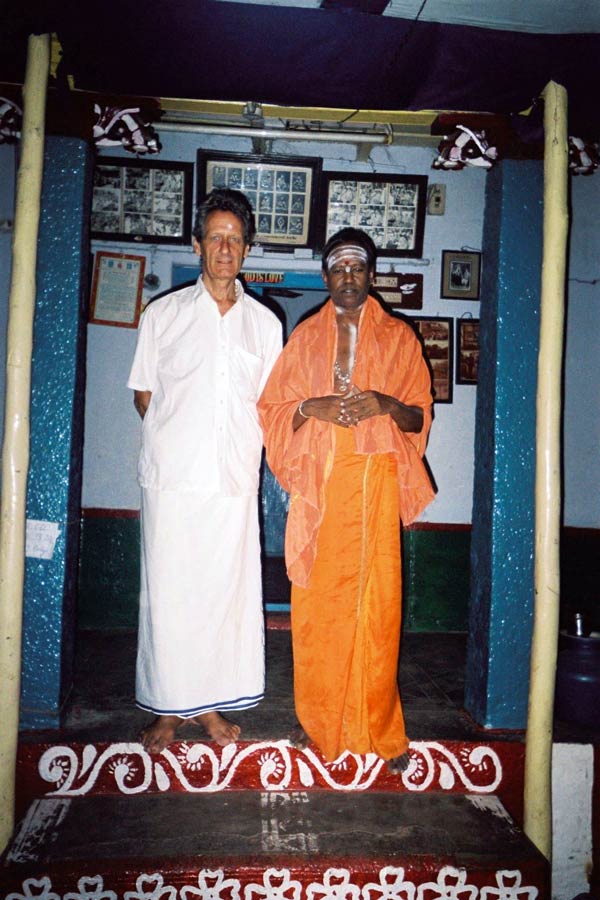
John Weddepohl with HH Srilasri Sivananda Pulippani Pathira Swamigal
Siva Giri
Travelling up Siva Giri in the locomotive carriage system that afternoon, I saw for the first time the exquisite beauty of the surrounding area. As the
molten sun set, in the distance sharp crystal like peaks pierced the late afternoon sky, while the Western Ghat mountains rose majestically out of the
emerald rice paddies on the eastern horizon defining the timeless beauty of the landscape.
I understood then why this area above all is considered sacred and recognized by the Siddhas as the place of worship and sadhana (spiritual
practice).
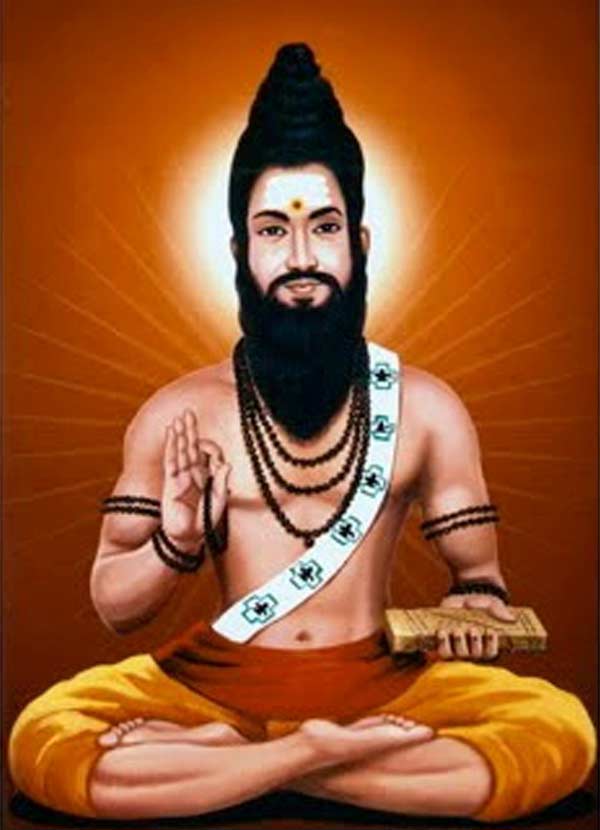
Bhoganathar great guru of Kriya Babaji
Bhoganathar or Bhogar's life history is immense.
His guru,named Kalange Nathar, is recognized as one of the 18 Siddhas.
An Indian by birth, Kalange Nathar initiated Bhogar in Para Vidya, supreme Self-Knowledge and then went to live in China.
Bhoganathar in writing on the siddhis (miraculous powers) or accomplishments of a yogi, states ‘Even with all of the sidhis without Vedanta - self knowledge - the yogis whole life is a waste.’
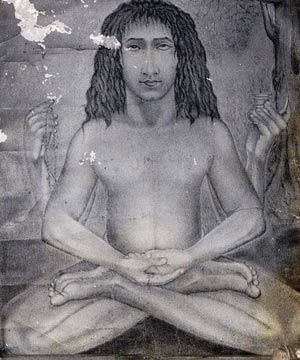
Drawing of BabaJi on a temple wall in Dunagiri Hill
Babaji, the deathless saint, mentioned in Swami Yogananda’s best selling Autobiography of a Yogi, has asked that Bhoganathar be acknowledged as his guru.
On Babaji’s instructions, Yogi S.A.A Ramaiah and some devotees installed a murti (statue) of Babaji at the Pulippani ashram honoring Bhogar as Babajis guru.
At some point Kalange Nathar called Bhogar to China to take over his mission.
On leaving Palani, Bhogar transferred his sakti, (vasi or vital energy/power), to Pulippani with strict instructions to follow him to
China should he sense Bhogar in any trouble.
In China Bhogar is known by his Chinese name Lao-Tzu Bo-Yang.
The Tao
It is said that after travelling and landing in China via the sea route, Bhogar helped the Chinese design and build a steamship for their naval fleet, the
largest fleet of ships in the world.
Pulippani eventually also travelled to China where he is known as Yu.
Confucius said of Lao-Tzu Bo-Yang “I know a bird can fly, a fish can swim, and an animal can run. For that which runs, a net can be fashioned; for that
which swims, a line can be strung. But the ascent of a Dragon on the wind into heaven is something which is beyond my knowledge. Today I have met Lao-Tzu,
who is perhaps like a Dragon.” describing the mastery Bhogar had over the serpent energy kundalini sakti.
Before the arrival of Bhogar in China there was no yin and yang or alchemy.
The arrival of alchemy set off a craze in China with the Emperor banning the private practice of alchemy.
Eventually leaving China, Bhogar, Pullipani, his closest disciples and a dog returned via the land route back to India.
As recorded in Taoist literature, at the request of the gatekeeper at the Han Ku mountain pass, Lao-Tzu Bo Yang crystallized his teachings. He did this in
two great books; the Tao Ching, with 37 verses, and the Te Ching with 42 verses. Along the way, they visited shrines in the Himalayas,
and met up again with his disciple Babaji. Here near Mt. Kailash, Bhogar composed his greatest work of 700,000 verses known as Bhogar Sapta Kandam
which was later abridged to 7,000 verses. He then visited Kåmakhya, the famous Shakti temple in Assam, Gaya India, and Arabia.
Returning to Tamil Nadu he introduced Chinese salts and chemistry, which he called Cina-caram and porcelain making.
In Sri Lanka Bhogar is known for the famous Sri Vidya Yantra, (or Sri Cakra) in Katirgama, revered throughout the world. It was here that
he initiated Babaji into Siddha Kriya Yoga before sending him to the Siddha Rishi Muni Agustya, the great sage and the founder of Siddha and
Ayurvedic medicine.
At Palani on his return, Boganathar attained what is known as soruba samadhi1 in a cave right under the statue he fashioned of Lord Murugan, on
Siva Giri. This is where the famous Temple of Palani is located.
With the icon of Lord Murugan installed, Bhogar retired into a cave directly under the statue. Pulippani Siddha was the last to see Bhogar as he rolled the
large rock over the caves entrance sealing the cave for good.
The people of Palani still refer to Bhogar as Swamiji. For them Bhoganatha is still very much alive and part of their lives.
Samadhi
As a young boy, Swamigal was helping his father and grandfather renovate the ashram when they suddenly unearthed a siddha buried underground. Startled they
did not know what to do.
“Alive?” I asked incredulously.
“Yes. Of course ALIVE” he replied, seeming shocked at my naivety. “Fully Alive! Full power!”
According to Swamigal, the hair and nails were growing around him and over him, covering his whole body like the roots of a tree. “Red body, long hair and
long nails growing…” Swamiji described his childhood memory.
Not wishing to disturb the deathless siddha, they erected a shrine around him and have placed a Siva Linga on top making it the shrine that it is today.
Swamigal said this was the third Pulippani in the dynastic lineage. A further six Pulippani’s are in Samadhi along the footpaths leading up Siva
Giri. These can be seen along footpath leading up to the temple.
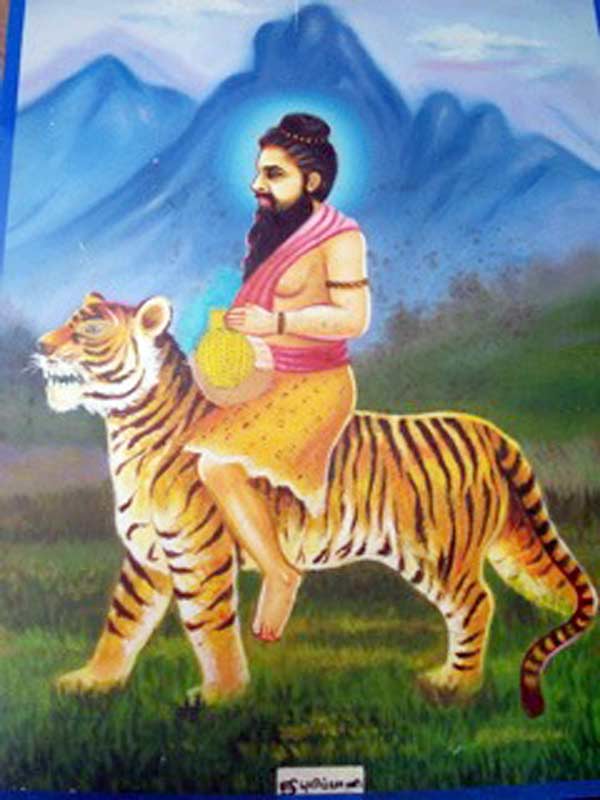
Pulippani Siddha
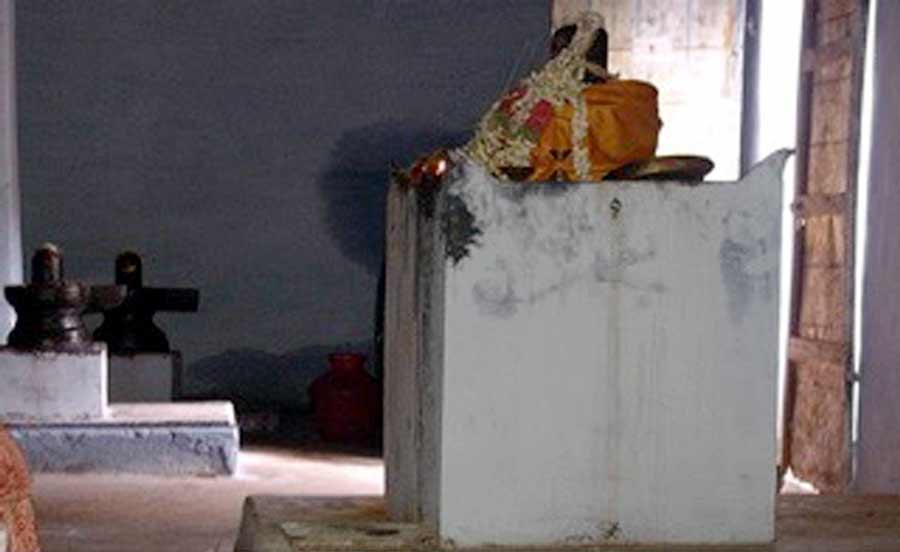
Siddha Samadhi in the back of Pullipani ashram
Meeting Patanjali’s Guru
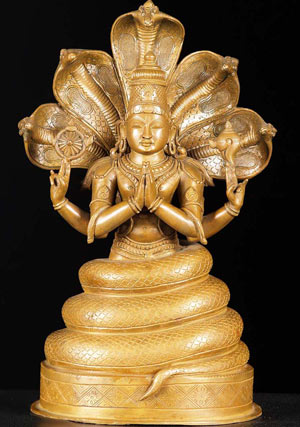 Sivananda Pulippani Swamigal graciously took me to many Bhumis, places of power in South India. One such journey took us to
Rameshwaram where another truly fascinating story emerged.
Sivananda Pulippani Swamigal graciously took me to many Bhumis, places of power in South India. One such journey took us to
Rameshwaram where another truly fascinating story emerged.
At 1:30 am one morning, Vastu, Swamiji's assistant, entered my room.
“Wake up. Wake up. Swamiji going.” He said. “We going to see your guru.”
“My Guru?” I asked.
“Yes, Yes. You western people think Patanjali is the great guru of yoga. We are taking you to visit your guru.”
Vastu kept moving his body meowing and making movements like a cat.
Patanjali is the codifier of yoga as we know it today. Writing his sutras on yoga he spelt out yoga in 196 verses which have become the reference manual of
yoga.
Travelling to Rameshwaram temple just eighteen kilometers from the Sri Lankan shoreline, we were met by the Shastri of the town who after doing a
ceremony with Swamigal took us for darshan at the temple. Bathing first in the ocean I was told to drop under water 32 times. We were then bathed
by priests inside the temple in 22 fresh water springs while they chanted mantras.
Guarding the entrance at the Patanjali shrine in the temple are two life like statues. One depicting Siddha Patanjali and the other his Guru Vyagrapadar.
I noticed Vyagrapada’s statue had the paws and legs of a tiger. (Hence Vastu’s meowing and mimicking the movement of a cat.)
The significance of our visit still didn’t hit me until later.
Seated alongside Patanjali Siddha’s Samadhi, we all sat in silent meditation. On completing our meditation, the astrologer Krishna travelling with us
turned to me and explained.
“Do you know what the significance of our visit is?”
“No” I said quietly.
“Vyagrapadar was Pulippani’s north Indian name. Vyagrapadar is Swamigal Pulippani’s ancestor.”
“The word Vyagra” Krishna explained, “means ‘Tiger’ and Padar means ‘feet’. Vyagrapadar or Pulippani Siddha, was Patanjali's guru.”
Dumbstruck I could hardly believe what I had just heard. Not only was I sitting right next to the Siddha Patanjali in Samadhi. Sitting with us was the
direct descendent of his Gurudev in a dynastic lineage that stretches back over 5000 years.
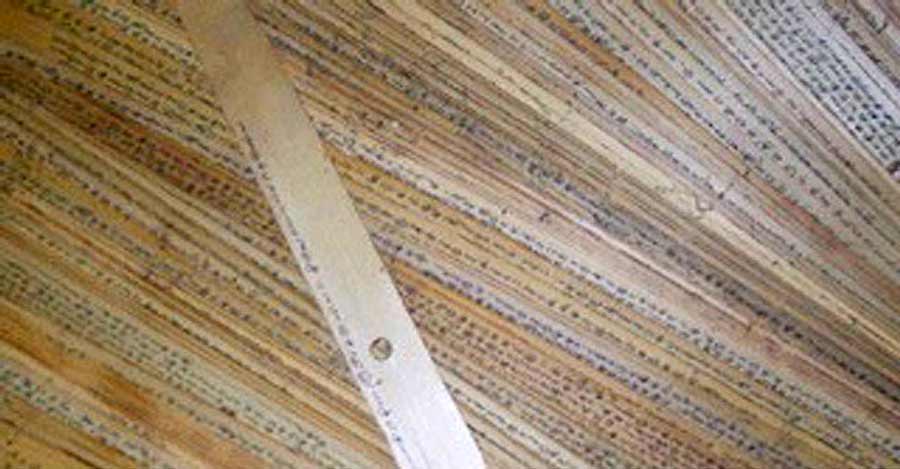
Three thousand year old palm manuscripts
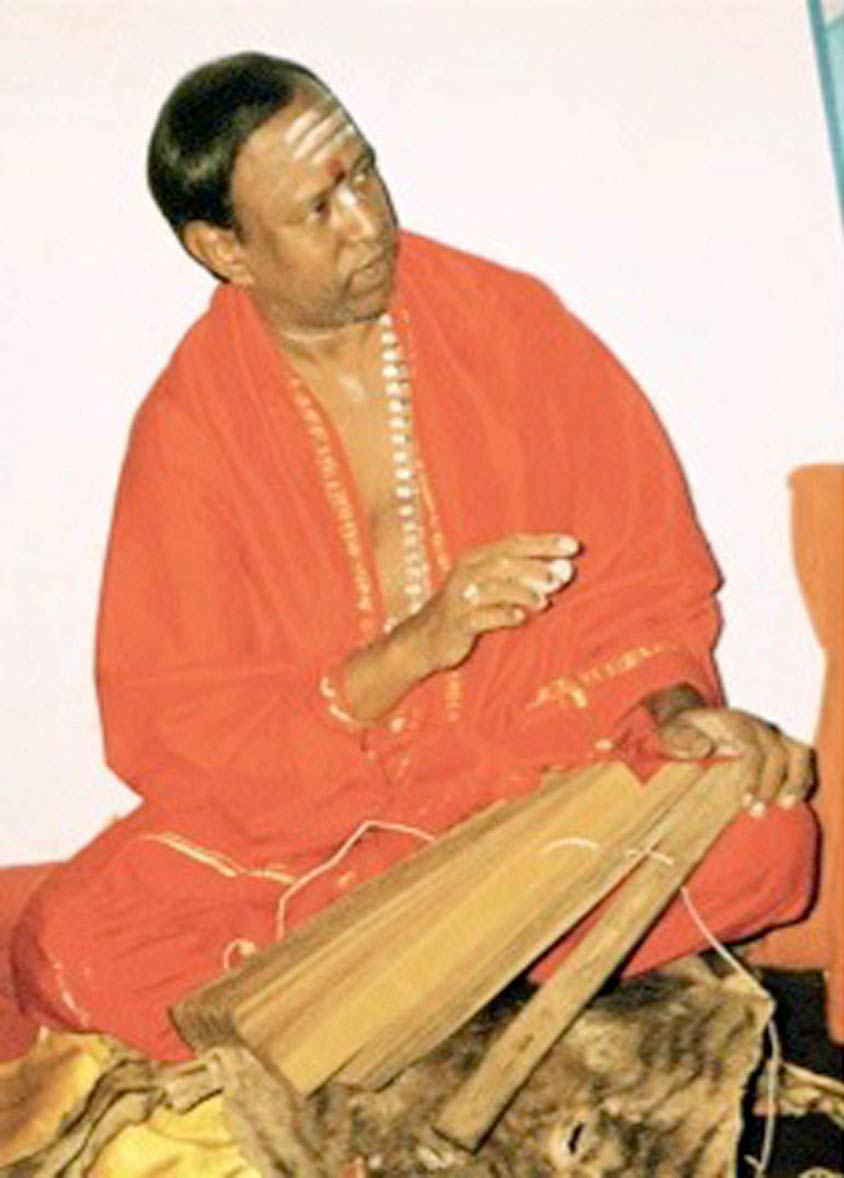
Sivananda Pulippani Pathira Swamigal explaining a palm manuscript
Pulippani Tradition
The tradition is custodian to a collection of 3000 year old palm leaf manuscripts containing the ancient practices of yoga, siddha medicine, and alchemy.
Among these original manuscripts are the teachings and practices called the Asta Yoga of Agustya, the source of Ashtanga Yoga or Raja yoga
referred to by Patanjali in his Yoga Sutras.
In these valuable manuscripts the Siddha’s have analyzed and isolated the 4448 diseases of mankind and have left the 4448 cures.
Swamigal informed me that while his grandfather was still alive, the London School of Medicine traveled all the way to Palani to honor his grandfather with
an honorary doctorate in medicine. He also said that both Russians and Americans have approached him by to buy the manuscripts. But as he explains, he
cannot let anyone have them. “Human frailty”, he says shrugging his shoulders.
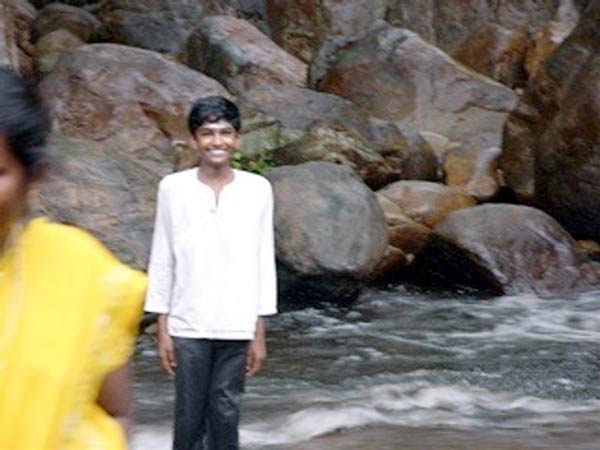
Yoganathan Pulippani the future head of the Pulippani tradition
Out of all the traditions that survive, the one that is known to have stood the test of time, still vibrantly alive today is the upanishadic
tradition. (Upanishad means sitting close or next to the truth.)
The teachings of Advaita Vedanta were taught by the great revivalist Adi Shankara who revived the teachings around 2500 years ago. Under the gurukul system the teaching of atma vidya is passed on through each generation by way of a Pramana (a means of knowledge) which
has always been the teacher.
Two most important mathas where the teaching is kept alive are Sringeri Sharada Peetha in Karnataka and Govardhana matha in
Jagannath Puri in Odisha.
Both however are not accessible for westerners or non-Hindus.
As Bhoganathar Siddha points out in his Sapta Kandam, out of all of our accomplishments, even the accomplishment of siddhis (miraculous
powers of a yogi), the most important is gaining Self Knowledge.
Being born into the Creation is the most exotic experience anyone will ever have in their lifetime.
Seeking exotic experiences in the end no experience is more profound or exotic than simply being human.